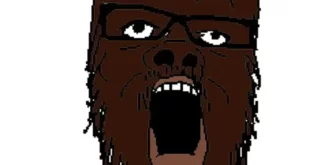Stuff Black People Don’t Like
February 11, 2015
Ever try and 500-piece jigsaw puzzle together only to find a few of the pieces are missing?
It’s infuriating.
You worked so hard to fit individual pieces together to reveal the picture on the box, only to come up short.

Well Erik Eckholm, a writer for the New York Times, appears to only be working with only a few of puzzle pieces when trying to understand why the Bell Curve City has a “stubbornly high murder rate”; of course, this puzzle is simply solved with one piece of information.
Race.
But because this is a piece of the puzzle apparently no one is allowed to consider, we get Eckholm’s hilarious reaction to what is essentially a problem courtesy of individual black people collectively driving away the civilization whites established in St. Louis. [St. Louis Puzzles Over Stubbornly High Murder Rate, New York Times, 2-10-15]:
Across from the Little Explorer’s Learning Center, diagonal to a crumbling house where heroin dealers and hangers-on often mill about, a garland of teddy bears adorns a telephone pole, a memorial to the latest victim to fall here at one of this city’s deadliest corners.
The victim was a 27-year-old man shot dead on Dec. 23, one of the last casualties in a year of surging gun violence.
“It’s nothing to get a firearm,” said Michael Shelton, who was badly wounded by gunfire eight years ago at this same corner, in the bleak Wells-Goodfellow neighborhood of north St. Louis, and is now determined to stay out of trouble. “I don’t know anybody who doesn’t carry or have easy access to one.”
Murder rates have fallen sharply in most of the country. But St. Louis is one of a few major cities, including Memphis and Washington, where the number of homicides jumped last year. It is also one of several cities, including Baltimore, Detroit, Gary, Ind., and New Orleans, where violent crime, concentrated in low-income minority neighborhoods, has remained stubbornly high, though down from the crack-driven peaks of the early 1990s.
The start of the new year was equally violent.
On Jan. 15, shaken by six murders in five shootings overnight, the city’s mayor, Francis Slay, called for more police, more surveillance cameras, more certain penalties for carriers of illegal guns and stronger gun laws, declaring: “Crime is the absolute No. 1 priority in the City of St. Louis.”
A seventh person was killed on the afternoon of the mayor’s news conference.
Jennifer M. Joyce, the city’s circuit attorney, or prosecutor, an elected position, complains that in St. Louis, the illegal possession of a gun is too often “a crime without a consequence,” making it difficult to stop confrontation from turning lethal.
At the same time, deeper social roots of violence such as addiction and unemployment continue unchecked. And city officials also cite what they call a “Ferguson effect,” an increase in crime last year as police officers were diverted to control protests after a white officer shot and killed Michael Brown, an unarmed black teenager in the nearby suburb on Aug. 9.
The violence is not uniform. Nearly all the increase in murders in St. Louis last year occurred in eight neighborhoods, said Richard Rosenfeld, a criminologist at the University of Missouri-St. Louis.
The largest jump was in Wells-Goodfellow, a desolate zone where more than a third of the houses are abandoned, liquor stores and churches are sprinkled among boarded-up shops and older residents fear stepping outside at night. In this neighborhood of fewer than 6,000 residents, 14 people were murdered in 2014, up from seven in 2013, for a per-person homicide rate five times the city average.
More precise police work is well and good, said James Clark, vice president for community outreach at Better Family Life, a nonprofit social service group based in Wells-Goodfellow just two blocks from the notorious intersection of Arlington and Ridge Streets, where the last murder of 2014 took place.
“But we’ve got to stop expecting the police to solve the crime problem,” Mr. Clark said, adding that only with a huge increase in social aid could a cultural collapse be prevented. “There is a void that the police can’t fill.”
Mr. Clark, a respected presence on the streets, is trying to help rescue youths and families one at a time, sending workers out to knock on doors and link people up with social services, from drug treatment to anger management to prenatal care.
“Our neighborhoods are resource deserts,” he said. “Every neighborhood needs a center with drug treatment, G.E.D. lessons, recreation for the kids.”
In 2007, after Mr. Shelton was shot, his grandmother was washing her car in front of the house on Ridge Street where she and her husband raised him and nine other grandchildren after their drug-addicted mothers lost custody.
Approached by a Better Family Life canvasser, she asked for help for her son.
Mr. Shelton, 25, has joined a support group at the agency, avoided a criminal record and hopes, with Mr. Clark’s help, to become certified as a security guard.
“I just found out that my girlfriend is pregnant,” he said. “I plan to marry her. I’m very excited.”
But why does the New York Times describe the Wells-Goodfellow neighborhood as “bleak?” Why does Mr. Clark call his community a “resource desert?”
Well, Well-Goodfellow is only .7% white and 97.5% black…
The borders of the neighborhood are defined by the St. Louis city limits on the north-western edge, Dr. Martin Luther King Drive to the south-west, Natural Bridge Avenue to the north-east and Union Boulevard to the south-east.
So a 97 percent white community must a be “resource ocean,” right? Well, Wells-Goodfellow was once 100 percent white, and Wikipedia describes it as just that:
The rich history of this area, particularly the streets close to the north and west city limits, has been all but lost to time. Part of the area dates to before the Civil War, and at one time it was the location of the popular amusement center Suburban Garden at Kennerly and Hodiamont, but its greatest growth came in the 1920s and 1930s with a mixture of single family homes, duplexes, four-family flats and apartment buildings. Before World War II the area was considered a particularly attractive community in which to live and rear a family. Hard to believe today, but it was semi-rural. For example, on Roosevelt Place large grassy pastures extended west from the four-family flat at 5865-67 to the western city limits and north to the Wabash railroad tracks. On the west ran the City Limits streetcar line on an in-the-woods embankment a block east of Kienlen Avenue; on the north ran the Wabash corridor, with heavy rail traffic including the Wabash Cannonball at 10:08 each morning and the Bluebird at 10:13. Leschen Rope and Wire factory on Hamilton between Kennerly and Roosevelt hummed with activity day and night and had its own railroad spur leading from the Wabash tracks. The four-family flat at 5865-67 Roosevelt turned out a Missouri lieutenant governor, a highly awarded nurse, a successful sculptor, and a celebrated teacher. Next to the building the occupant of one flat kept horses in a barn and blackberry patches stretched westward. A well-known case involving alien abductions—or the illusion of them—also took place in this building over an extended time beginning in the 1940s before there were any flying saucer images or knowledge in the culture and it affected children in multiple families in the building. The case is known to experts as high as the university level; the children involved only learned of each other’s experiences, and the effects on their subsequent lives, 40 years after the fact. Laclede School on Kennerly Avenue at Goodfellow was, through the 1940s and early ’50s, considered a choice grade school in the city for both students and teachers. The principal Fred S. Milam was well known for hiring the best teachers and then letting them teach, valuing autonomy and expertise. Likewise, the Wellston library was one of the most popular in the city; the children came from middle-class or lower-middle-class homes without many extras and kept the small library jammed on Saturdays as they selected which books they would next read. The area mixed a heavy Catholic population and a heavy Jewish population with other religions with harmony. When the exodus to the suburbs in the late 1950s moved swiftly the neighborhoods underwent a drastic change and today much of the area’s structures are long gone. Many people who grew up in the area believe the next logical development is redevelopment of the area, as has happened with hard-luck areas in many other cities. Laclede School notably held on to its reputation through hard years for the neighborhood and the beautiful building now boasts a large gym in what had been the girls’ playground.
Remember: whites were displaced by blacks decades ago (as was the ability for white people to build long-term wealth in their homes via Restrictive Covenants, with HUD’s usage of Section 8 Vouchers destroying the ability to build short-term wealth now…) in Wells-Goodfellow and other North St. Louis communities.
And over time, the new black inhabitants of these “resource oceans” dried up whatever remained of the civilization whites left behind. [Onetime center of St. Louis’ black middle class now fights high murder count, St. Louis Post-Dispatch, 1-23-15]:
The Ville is filled with what [Greater Ville Preservation Commission Director Harold] Moore calls “dollhouses” — empty shells where much of the brick has been stripped away by thieves, exposing open rooms or entire floors of rotting furniture. Even one of the brightest spots — two blocks of newer houses on Lincoln Avenue — has a crumbling bungalow just waiting for a bulldozer.
And why is North St. Louis littered with those “dollhouses”(the abandoned remains of the individual dreams of white people before Martin Luther King’s ‘Dream’ supplanted whatever hopes whitey had for the future…)?
The puzzle is so simple, and it only needs one piece…
Race.
When Wells-Goodfellow was nearly 100 percent white, the city boasted a rich history because those individual white people helped collectively make it rich; today, at nearly 100 percent black, the individual blacks how call it home have made it “bleak” and a “resource desert.”
The puzzle is so simple…
 Daily Stormer The Most Censored Publication in History
Daily Stormer The Most Censored Publication in History


